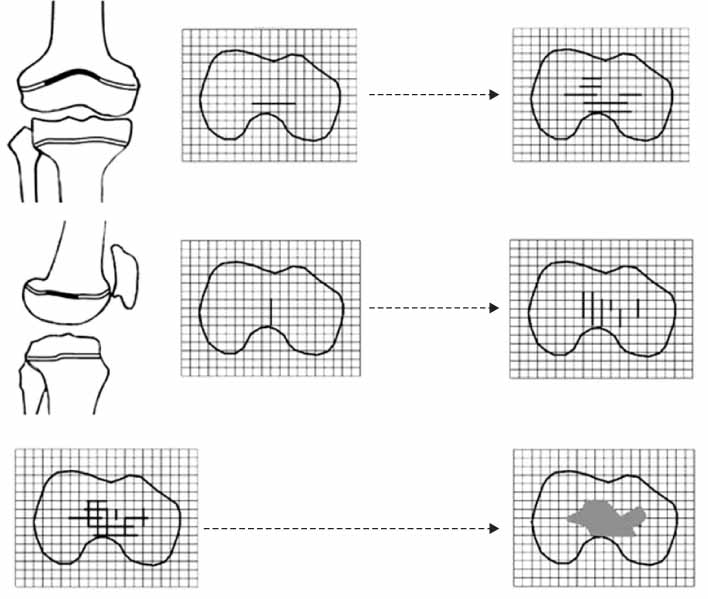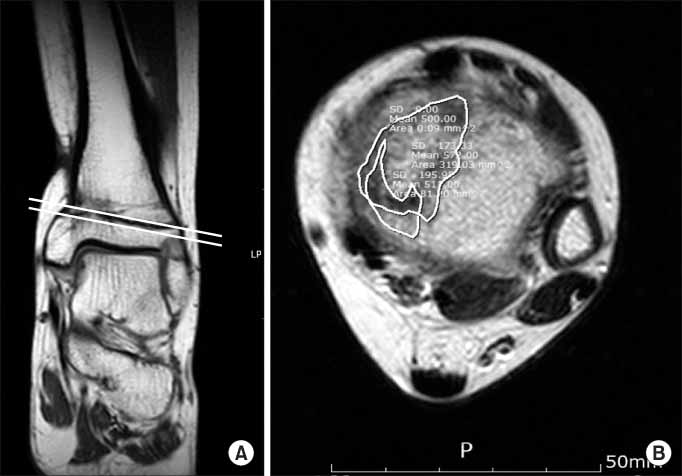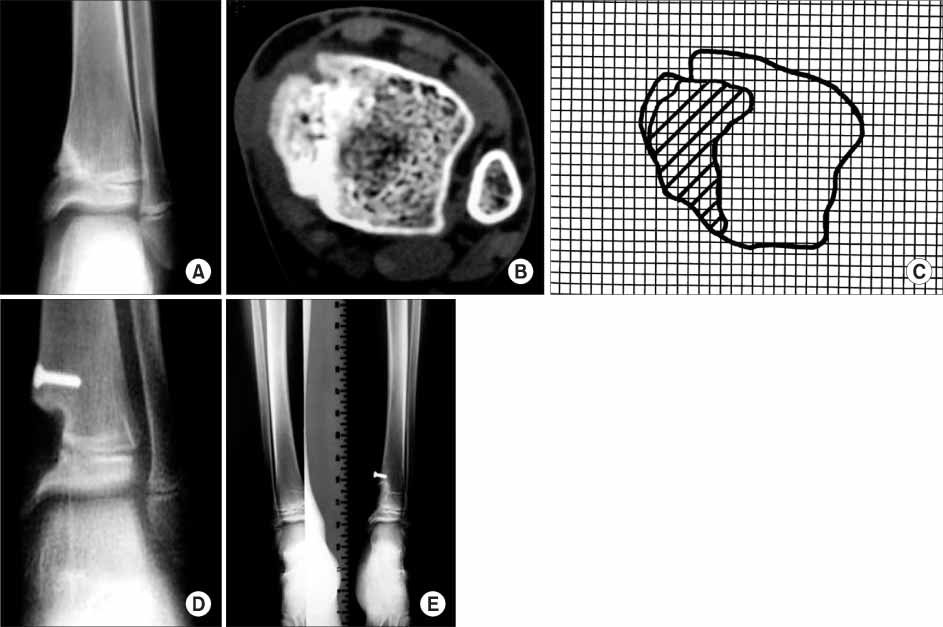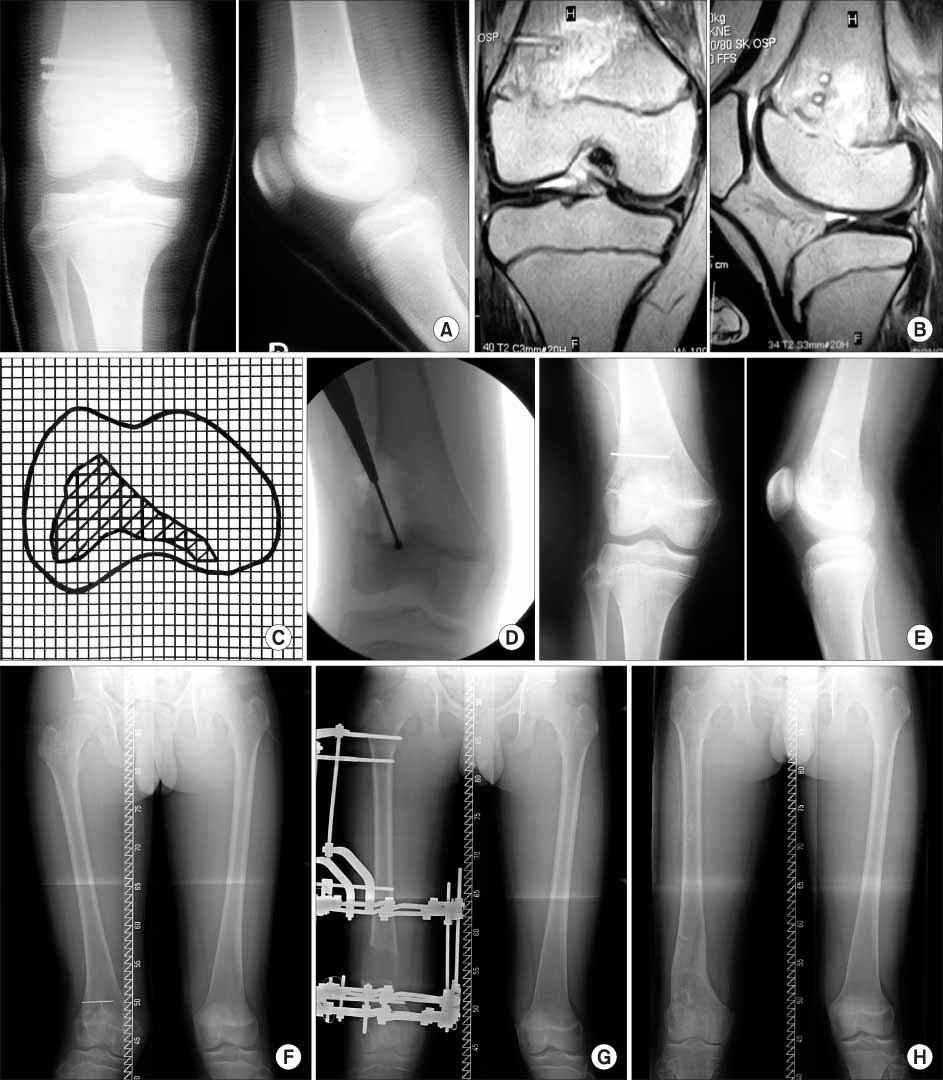J Korean Orthop Assoc.
2008 Oct;43(5):601-609. 10.4055/jkoa.2008.43.5.601.
Surgical Treatment of Partial Closure of Growth Plate: Physeal Bar Resection and Free Fat Graft
- Affiliations
-
- 1Department of Orthopaedic Surgery, College of Medicine, Pusan National University, Pusan, Korea. kimht@pusan.ac.kr
- KMID: 2186422
- DOI: http://doi.org/10.4055/jkoa.2008.43.5.601
Abstract
-
PURPOSE: To evaluate the results of physeal bar resection and free fat graft as a treatment method for partial epiphyseal closure.
MATERIALS AND METHODS
Thirteen cases of partial epiphyseal closure (4 of the distal femur, 8 of the distal tibia and one of the distal radius) were subjected to physeal bar resection. All of the cases were caused by trauma. The physeal bar was central in 3 cases, peripheral in 9, and mixed (central-peripheral) in 1. Mean patient age at surgery was 10.7 years and mean follow-up period was 47 months. Final results were evaluated by a modified Williamson-Staheli classification.
RESULTS
Results at final follow-up were as follows: 6 satisfactory (3 excellent and 3 good) and 7 unsatisfactory (5 fair and 2 poor). Satisfactory results according to location and region of the physeal bar were as follows: distal tibia, 5 of 8 cases; distal femur, 1 of 4; central, 1 of 3; peripheral, 4 of 9; and mixed, 1 of 1. When considered by areal extent, physeal bars occupying 30% or less of the bone's cross-sectional area showed satisfactory results in 5 of 7 cases, while in 6 cases with the physeal bar over 30%, 5 were unsatisfactory.
CONCLUSION
Accurate preoperative evaluation of the size and type of the physeal bar, and meticulous surgical technique, are important predictors of satisfactory outcome of physeal bar resection. Cases where the physeal bar extent exceeded 30% had mostly unsatisfactory results.
MeSH Terms
Figure
Reference
-
1. Bright RW. Operative correction of partial epiphyseal plate closure by osseous-bridge resection and silicone-rubber implant. An experimental study in dogs. J Bone Joint Surg Am. 1974. 56:655–664.2. Bright RW. Partial growth arrest: identification, classification and results of treatment. Orthop Trans. 1982. 6:65–66.3. Broughton NS, Dickens DR, Cole WG, Menelaus MB. Epiphyseolysis for partial growth plate arrest. Results after four years or at maturity. J Bone Joint Surg Br. 1989. 71:13–16.
Article4. Cady RB, Spadaro JA, Fitzgerald JA, Pinkes J, Albanese SA. The effects of fat interposition for central-physeal defects. A histologic study in rabbits. Clin Orthop Relat Res. 1992. 282:304–309.5. Carlson WO, Wenger DR. A mapping method to prepare for surgical excision of partial physeal arrest. J Pediatr Orthop. 1984. 4:232–238.6. Choi IH, Yoo WJ. Prognostic factors of physeal bar resection and fat graft interposition in the treatment of partial physeal arrest. J Korean Orthop Assoc. 1996. 31:649–658.
Article7. Hasler CC, Foster BK. Secondary tethers after physeal bar resection: a common source of failure? Clin Orthop Relat Res. 2002. 405:242–249.8. Kasser JR. Physeal bar resections after growth arrest about the knee. Clin Orthop Relat Res. 1990. 255:68–74.
Article9. Khoshhal KI, Kiefer GN. Physeal bridge resection. J Am Acad Orthop Surg. 2005. 13:47–58.
Article10. Klassen RA, Peterson HA. Excision of physeal bars: the Mayo Clinic experience 1968-1978. Orthop Trans. 1982. 6:65.11. Langenskiöld A, Heikel HV, Nevalainen T, Osterman K, Videman T. Regeneration of the growth plate. Acta Anat (Basel). 1989. 134:113–123.
Article12. Langenskiöld A. Surgical treatment of partial closure of the growth plate. J Pediatr Orthop. 1981. 1:3–11.
Article13. Langenskiöld A. Traumatic premature closure of the distal tibial epiphyseal plate. Acta Orthop Scand. 1967. 38:520–531.
Article14. Lee DY, Choi IH, Cung CY. An experience of bone bridge resection and free fat interposition for partial epiphyseal plate closure. J Korean Orthop Assoc. 1990. 25:187–196.
Article15. Mizuta T, Benson WM, Foster BK, Paterson DC, Morris LL. Statistical analysis of the incidence of physeal injuries. J Pediatr Orthop. 1987. 7:518–523.
Article16. Ogden JA. Ogden JA, editor. Management of growth mechanism injuries an arrest. Skeletal injury in the child. 2000. 3rd ed. New York: Springer-Verlag;209–242.17. Ogden JA. The evaluation and treatment of partial physeal arrest. J Bone Joint Surg Am. 1987. 69:1297–1302.
Article18. Peterson HA. Partial growth plate arrest and its treatment. J Pediatr Orthop. 1984. 4:246–258.
Article19. Peterson HA, Madhok R, Benson JT, Ilstrup DM, Melton LJ 3rd. Physeal fractures: Part I. Epidemiology in Olmsted County, Minnesota, 1979-1988. J Pediatr Orthop. 1994. 14:423–430.20. Vickers DW. Premature incomplete fusion of the growth plate: causes and treatment by resection (physolysis) in fifteen cases. Aust N Z J Surg. 1980. 50:393–401.21. Williamson RV, Staheli LT. Partial physeal growth arrest: treatment by bridge resection and fat interposition. J Pediatr Orthop. 1990. 10:769–776.
- Full Text Links
- Actions
-
Cited
- CITED
-
- Close
- Share
- Similar articles
-
- An Experience of Bone Bridge Resection and Free Fat Interposition for Partial Epiphyseal Plate Closure
- Prognostic Factors of Physeal Bar Resection and Fat Graft Interposition in the Treatment of Partial Physeal Arrest
- Experimental Study for the Effects of Free Physeal Transplantation to Regain Bone Grwoth after Partial Physeal Injury
- Conservative Treatment of Physeal Bar after Triradiate Cartilage Injury
- Cultured Chondrocyte Transplantation in the Damaged Growth Plate





